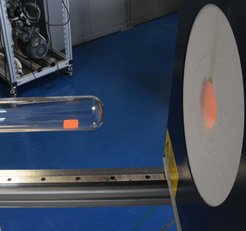Deuterium retention in tungsten-based materials

Deuterium can be detected using a nuclear reaction with the helium isotope 3He. This can be performed at IPP’s accelerator laboratory with the 3-megavolt tandem accelerator. By varying the energy of the 3He beam a concentration depth profile for the deuterium can be measured to a depth of 10 µm even in tungsten.
Another possibility to analyse the deuterium content of tungsten samples is the “thermal desorption” process, which also is implemented at IPP. Here a deuterium containing sample is heated in vacuum up to 1000°C. This mobilises the deuterium – it leaves the sample and can be detected by a mass spectrometer. This is complementary to the first method: it does not yield any depth information, but gives the total amount of deuterium even if it comes from a larger depth out of the sample than can be reached by the nuclear reaction method.
